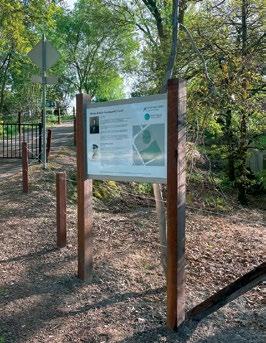
2 minute read
Fulfilling the Dunn Bickle vision
For the past eight years, the Mount Barker Branch of the National Trust has been working in collaboration with the Mount Barker District Council to secure the future of recreational land in the centre of the town.

Advertisement
The land includes what is now known as Dunn Oval (formerly Dunn Park), which was donated to the town by John Dunn in 1892 to mark his 90th birthday; and more than seven adjoining acres donated six years later by Dr Leonard Watkins Bickle, a former Mount Barker physician and surgeon. In 2017, the two parcels were consolidated in the Mount Barker District Council Development Plan as the Dunn Bickle Community Policy Area, which incorporates a caravan park and the town’s current public swimming pool, built by volunteers in the 1950s.
With a new swimming facility under construction at a different location and the pressure of development in the town, the National Trust branch believes it is more important than ever to protect the original vision of the two philanthropists to provide a ‘recreation-ground worthy of the town, attracting visitors and so proving a benefit to the place,’ and to remind residents of their legacy, which has been largely lost from memory.
Last year the branch received a community grant from the council to erect interpretive signage acknowledging the history of the land. Situated alongside the town’s popular linear trail, the new sign was officially unveiled in April by local Member of Parliament Dan Cregan and Mayor David Leach.

John Dunn died at The Laurels on 13 October 1894, at the age of 92. The local Courier summed up his significance to the town with the observation that he and Mount Barker were ‘so wrapped up in one another that it was difficult to think of one without the other.’ On the day of Dunn’s funeral, a special train brought mourners up from Adelaide, and more than 40 horsedrawn vehicles followed his hearse from his home to the Dunn Memorial Church, and then on to the Wesleyan cemetery (later the Mount Barker Cemetery). The newspaper reported:

Mount Barker has long been proud of the man who did so much to bring prosperity and fame to it, and practically all the inhabitants joined in the obsequies. Shops and offices were shut, flags flew at half mast, and tokens of mourning were universal. There was nothing pretentious about the funeral pageant, but the sincere and spontaneous manner in which everyone who could possibly make it convenient to do so left business engagements to follow the body to its grave spoke more clearly than any outward pomp could do of the respect and esteem in which Mr. Dunn was held.
Dunn was interred in the family crypt with the remains of Ann and their daughter, Eliza. The substantial monument that sits above the crypt was completed in August 1895. Carved in Italy from five tons of Sicilian white marble, it was commissioned through Hahndorf monumental mason Carl Bom, whose memorials can be seen throughout the cemetery. The simple but tasteful design features an urn surmounting a plain column resting on square marble tiers.
Unfortunately, the gravesite, which was once the focal point of the old cemetery precinct, has fallen into disrepair and is in urgent need of restoration. The Mount Barker Branch of the National Trust has launched an appeal to redress this situation as a tribute to John Dunn and in recognition of his substantial contribution to Mount Barker. The success of the project is entirely dependent on public donations.











